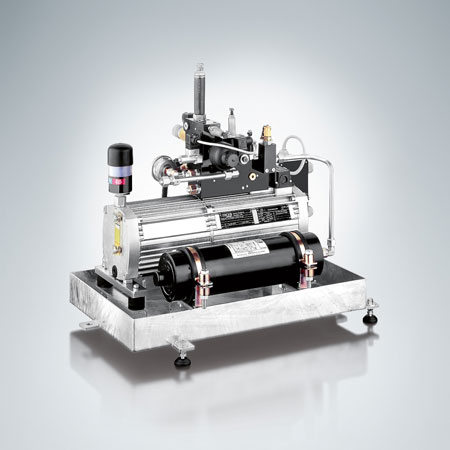The muscle that pitches wind-turbine blades can come from either a hydraulic or electric device on most turbines rated at and below 2.5 MW. But for turbines over 3 MW, the job of pitching blades more often falls to hydraulics. And hydraulics can handle more.
“Hydraulics in wind turbines usually refers to the assemblies for brake control and regulating the blade setting through pitch control,” said Bob Pettit, Corporate Technical Director at HAWE Hydraulics.
In a nutshell, the process of turning wind into electricity involves a drivetrain turned by a rotor of two or three blades and related equipment. While small turbines often have fixed rotor blades – they do not pitch – larger turbines require blades that pitch, and so are mounted on bearings.
To drive each blade to its best pitch position requires a hydraulic pump, motor, reservoir and associated equipment. For example, the pump and motor are usually mounted in the nacelle while hydraulic pistons are mounted in the hub. A hydraulic rotary joint allows passing hydraulic fluid from the stationary side to the rotating side. Pitch control then varies the pitch of the blades to maintain nearly-constant rotational speed at the generator.
Aside from wind velocity changes, the pitch of the blades may vary even during a 360-degree rotation of a single blade. Such control is necessary because wind velocity at the 12 o’clock position may be significantly different from its velocity at the 6 o’clock position, according to Afzal Ali, Director of Marketing at Deublin. Typically, the pitch of each blade varies continuously and independently.
In an emergency, hydraulic pitch control can operate without an external power supply thanks to an accumulator, a sort of hydraulic battery. Hydraulic actuation provides the shortest stopping time, a wider range of operating temperatures than alternative systems and it’s backlash free.
The rotor brake, also hydraulically activated, engages during emergency stops as well as service work when the turbine is manually shut down. Another hydraulic system, one that activates yaw brakes, is comprised of several hydraulically-activated brake calipers which act on a break disk at the top of the tower. During normal turbine operation, brake calipers are under maximum pressure to keep the nacelle facing the wind direction.
Hydraulic equipment usually includes an accumulator as a way to store energy in case of an emergency shutdown. The system is usually designed to fill the accumulator during off-demand periods, when pump flow is not allocated to system actuators. The pressurized fluid stored in the accumulator can then pitch the turbine blades to a safe position where they can stay until power is restored or the halting condition is corrected.
Researchers are considering the advantages of replacing gearboxes in some turbines with hydraulic transmissions.
“For instance, there is some compressibility in the fluid that prevents shock loading to the generator,” said University of Minnesota and Mechanical Engineering Professor Kim Stelson. “Hydraulics equipment is lighter than the conventional equipment it replaces. Also, control is somewhat simplified. Controls in a conventional turbine are based on torque, a quantity that can be difficult to measure, although it can be approximated with current. But in a hydraulic transmission, it is measured with pressure from the pump and that is more convenient.”
Other researchers are also devising ways to replace gearboxes in large turbines. While working on the development of a variable-displacement hydraulic machine in the 1980s, engineers at Artemis Intelligent Power found a way to improve hydraulic efficiency. The company replaced the mechanical valves and swash-plates of conventional variable-displacement hydraulic machines with computer-controlled high-speed solenoid-valves. This opens new markets for hydraulics because Digital Displacement machines are efficient at all load levels and have super-fast response to computer control. This development has led one Japanese turbine OEM to build a multi-MW unit with a hydraulic drive that is now working off the coast of Japan near Fukushima.
Filed Under: Blades, Components, Featured, Gearboxes, Hydraulics, Nacelle, News, Pitch & yaw, Turbines






Thanks for your article about wind power. It seems that there are a significant number of parts and systems that use hydraulics and would need to use a hydraulic power pump unit to keep things working efficiently. We have a wind farm that is just south of where I live. Thanks for helping me better understand what goes on inside of those windmills.